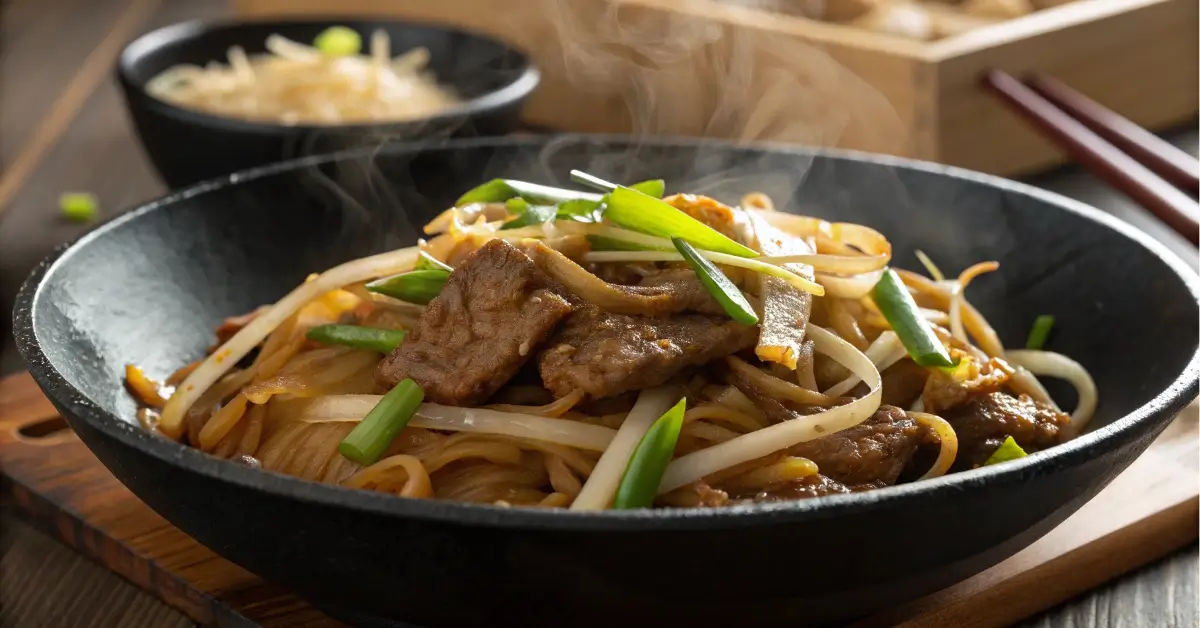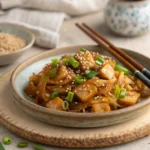If you love Asian food, chances are you’ve come across the bold, savory flavors of chow foon—a classic Cantonese noodle dish that’s as satisfying as it is simple. Known for its wide, slippery rice noodles and smoky wok aroma, chow foon has become a staple in Chinese-American takeout and home kitchens alike. But there’s more to this noodle dish than just beef and soy sauce. In this guide, we’ll dive into what makes chow foon special, how it compares to other noodle dishes like chow mein and mei fun, and how you can make it at home—even if you’re a total beginner.
We’ll also cover cooking tips, health insights, recipe variations, where to buy the best noodles, and delicious side ideas to elevate your next meal.
Looking for inspiration? Try our Crispy Salmon Bites Air Fryer as a starter to pair with your homemade chow foon.
Let’s kick things off with the basics.
Jumo to:
What Is Chow Foon? Origins and Basics
Understanding Chow Foon: Definition and History
Chow foon (also known as chao fen or ho fun) refers to a Chinese stir-fried noodle dish made with wide, flat rice noodles. These noodles are known for their chewy texture and ability to soak up rich, umami sauces. Typically, chow foon is cooked quickly over high heat, using a technique called wok hei, which gives the noodles their signature smoky flavor.
The dish originated in Cantonese cuisine, particularly in the Guangdong province of southern China. Over time, it became a beloved part of Chinese-American menus, especially as a hearty alternative to thinner noodles like those in chow mein or lo mein. In fact, beef chow foon is one of the most iconic dishes you’ll find in both dim sum spots and takeout joints across the U.S.
Some regional variations include seafood or chicken instead of beef, and modern spins include vegan and gluten-free options. While traditional chow foon uses simple ingredients, it’s the cooking method and balance of flavors that elevate it to a true comfort food classic.
Cultural Significance in Cantonese and Chinese-American Cuisine
In Cantonese culture, chow foon is more than just a meal—it’s a symbol of community. Shared at big family dinners, festivals, and late-night snacks, chow foon often represents warmth, togetherness, and tradition. In Chinese-American culture, it found a new life in bustling Chinatowns and suburban takeout counters, adapting to local tastes while retaining its core identity.
In fact, many American diners first experience Cantonese food through dishes like chow foon. Its approachable ingredients, bold seasoning, and satisfying texture make it a gateway dish for newcomers to Chinese cuisine. The dish has also found a place in modern food culture as chefs reimagine it in fusion forms or showcase it in high-end restaurants.
Whether you’re enjoying it with traditional oyster sauce or exploring a plant-based version, chow foon continues to bridge cultures and generations through its timeless appeal.
Key Ingredients in Authentic Chow Foon Recipes
Flat Rice Noodles: Texture and How They’re Made
At the heart of every chow foon recipe is the star of the show: flat rice noodles. These wide, slippery noodles—often called ho fun—are made from a simple mix of rice flour, water, and a pinch of tapioca or cornstarch for stretch. Their glossy finish and smooth texture are perfect for stir-frying and soaking up flavor.
What makes them stand out? It’s the mouthfeel. These noodles are thicker and wider than most, giving chow foon its signature chew. Whether you use store-bought or homemade versions, always rinse them gently with warm water to separate the strands before stir-frying. Be sure to avoid overcooking—these noodles go from chewy to mushy in seconds.
While fresh noodles offer better elasticity and texture, you can use dried noodles as a backup. Just soak them in hot water until pliable. Learn more about noodle prep in our Ninja Foodie Recipes for quick stir-fry tips.
Protein Choices: Beef, Chicken, Shrimp, and Vegan Options
Classic beef chow foon uses thinly sliced flank steak or skirt steak marinated in soy sauce, sesame oil, and cornstarch. The result? Juicy, tender meat that crisps lightly in the wok and adds depth to the dish.
But don’t stop there. You can personalize your chow foon by switching up the protein:
| Protein Type | Flavor Profile | Cooking Tip |
|---|---|---|
| Chicken | Mild, juicy | Marinate with ginger & garlic |
| Shrimp | Sweet, briny | Cook separately, then toss in late |
| Tofu | Nutty, soft (vegan option) | Use firm tofu, pan-seared first |
| Mushrooms | Umami, earthy (vegan) | Use shiitake or king oyster |
Whether you’re going meaty or meatless, the goal is the same—pairing proteins that blend with the richness of the sauce while letting the noodles shine.
Essential Sauces and Vegetables in Chow Foon
A flavorful chow foon relies on a balance of savory and slightly sweet. Here’s what goes into the sauce:
- Dark soy sauce – for color and depth
- Light soy sauce – for salinity and sharpness
- Oyster sauce – for that umami punch
- Shaoxing wine – a traditional rice wine for aroma
- Sesame oil – a finishing oil for nuttiness
If you’re going vegan, swap oyster sauce with mushroom soy or hoisin sauce.
As for vegetables, the usual suspects include:
- Bean sprouts – for crunch
- Green onions – for brightness
- Onions – caramelized for sweetness
- Bell peppers or bok choy – for color and contrast
Don’t miss our Slow Cooker Cube Steak Recipe to see how sauces build richness in Asian-style meals.
Together, these ingredients deliver the bold, smoky, umami-rich taste that makes chow foon unforgettable.
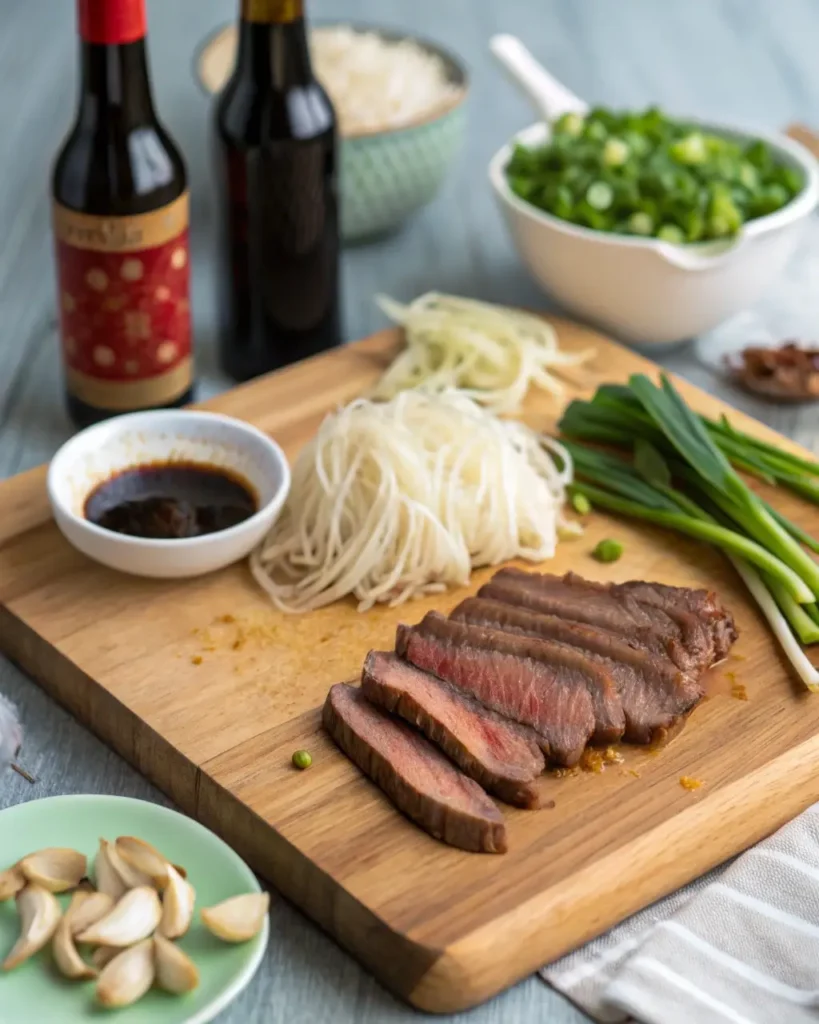
Chow Foon vs. Other Chinese Noodles
Difference Between Chow Foon and Chow Mein
If you’ve ever stared at a Chinese takeout menu wondering whether to order chow foon or chow mein, you’re not alone. While they may sound similar, they’re quite different in texture, taste, and technique.
Chow foon uses flat, wide rice noodles that are stir-fried until they develop a smoky, slightly charred edge from wok hei. Chow mein, on the other hand, is typically made with thin, egg-based wheat noodles. These noodles are either soft or pan-fried to a crispy golden finish.
Here’s a quick comparison:
| Feature | Chow Foon | Chow Mein |
|---|---|---|
| Noodle Type | Flat, wide rice noodles | Thin, egg wheat noodles |
| Cooking Method | Stir-fried over high heat | Stir-fried or pan-fried (crispy) |
| Texture | Chewy, slippery | Soft or crispy |
| Common Proteins | Beef, chicken, shrimp | Chicken, beef, shrimp, pork |
While both are noodle-based stir-fry dishes, chow foon brings a more velvety, savory bite compared to the sometimes crunchy finish of chow mein. Think of it as comfort food with a softer edge.
What Sets Chao Fen Apart From Chow Foon
The term chao fen (炒粉) is often used interchangeably with chow foon, especially in Mandarin-speaking regions. Technically, they both refer to stir-fried rice noodles. However, there’s a subtle difference in context.
- Chow foon is the Cantonese pronunciation of stir-fried flat rice noodles.
- Chao fen is the Mandarin term for the same, and it may refer more broadly to various styles of stir-fried noodles, not just the wide type.
In practice, when someone refers to chao fen, they might be talking about a stir-fried noodle dish that includes thin rice vermicelli (mei fun) or flat noodles, depending on the region. In contrast, chow foon always points to the wide rice noodle variety, making it more specific.
So, while the dishes might overlap in preparation, the names help distinguish the regional and linguistic origins. Discover great ideas like our Starbucks Banana Nut Bread Recipe to balance sweet and savory cravings after your chow foon dinner.
Chow Foon vs. Chow Mei Fun: Texture and Preparation Styles
Another noodle that’s often confused with chow foon is chow mei fun. Mei fun noodles are made from rice flour, like chow foon, but they’re very thin—almost like angel hair pasta. Here’s how they differ:
| Feature | Chow Foon | Chow Mei Fun |
|---|---|---|
| Noodle Thickness | Wide and flat | Thin and round (vermicelli) |
| Cooking Texture | Chewy and soft | Light and springy |
| Common Usage | Hearty dishes, rich sauces | Lighter stir-fries or soups |
| Popular Variants | Beef chow foon | Singapore mei fun (with curry) |
Chow foon is ideal for those who love a rich, velvety noodle base that grabs onto sauce. In contrast, chow mei fun offers a more delicate texture that pairs well with light vegetables and seafood.
Both have their place at the table, but if you’re craving a deeply flavorful, satisfying bite, chow foon is your go-to.
Step-by-Step Chow Foon Cooking Techniques
Prepping Flat Rice Noodles for Best Results
Cooking delicious chow foon starts before you even touch the wok. Proper noodle preparation is key to achieving the dish’s signature texture—tender, yet just firm enough to hold up under high heat.
If you’re using fresh rice noodles, gently separate them by hand. They can clump together due to their natural stickiness, so use a little warm water or a few drops of oil to loosen them without tearing.
If you’re working with dried rice noodles, soak them in warm (not boiling) water for 30–45 minutes or until they’re pliable but not mushy. Avoid over-soaking or boiling, which can ruin the consistency and cause them to fall apart in the wok.
Before stir-frying, pat your noodles dry. This prevents steaming in the wok and encourages a better sear—crucial for achieving the desirable wok hei effect, the slightly charred, smoky flavor that defines great chow foon.
Stir-Frying Like a Pro: Tips for Wok Hei Flavor
The true magic of chow foon lies in the stir-frying. High heat, fast motion, and the right oil are essential.
Here’s how to do it like a pro:
- Use a wok or large skillet—The larger the surface area, the better your ingredients will sear instead of steam.
- Crank up the heat—You want it smoking hot. This helps create that charred flavor known as wok hei, a hallmark of authentic chow foon.
- Add oil with a high smoke point—Peanut or avocado oil are great options.
- Sear the protein first—Get a good crust, then remove it to avoid overcooking.
- Quick-fry the aromatics—Garlic, onions, and scallions go in next.
- Toss in the noodles and sauces—Move fast with your spatula to coat every strand.
- Return the protein and add veggies—Finish with a drizzle of sesame oil and serve immediately.
Timing is everything. Chow foon should be cooked in under 5–7 minutes once your ingredients hit the pan. This ensures everything stays crisp, tender, and flavorful.
Common Mistakes to Avoid When Making Chow Foon
Even seasoned home cooks slip up when making chow foon. Here are some pitfalls to dodge:
- Overcooking the noodles – They’ll turn mushy and lose their bite.
- Crowding the wok – This steams the food and kills your wok hei.
- Using too much sauce – You want the noodles coated, not drowning.
- Skipping the marinade – For beef or chicken, a quick soy-cornstarch marinade adds depth and tenderness.
- Low heat – Stir-frying at low temp creates soggy noodles and no sear.
Want to practice your stir-fry game first? Don’t miss our Crispy Salmon Bites Air Fryer for a quick, protein-packed dish that also benefits from high-heat cooking skills.
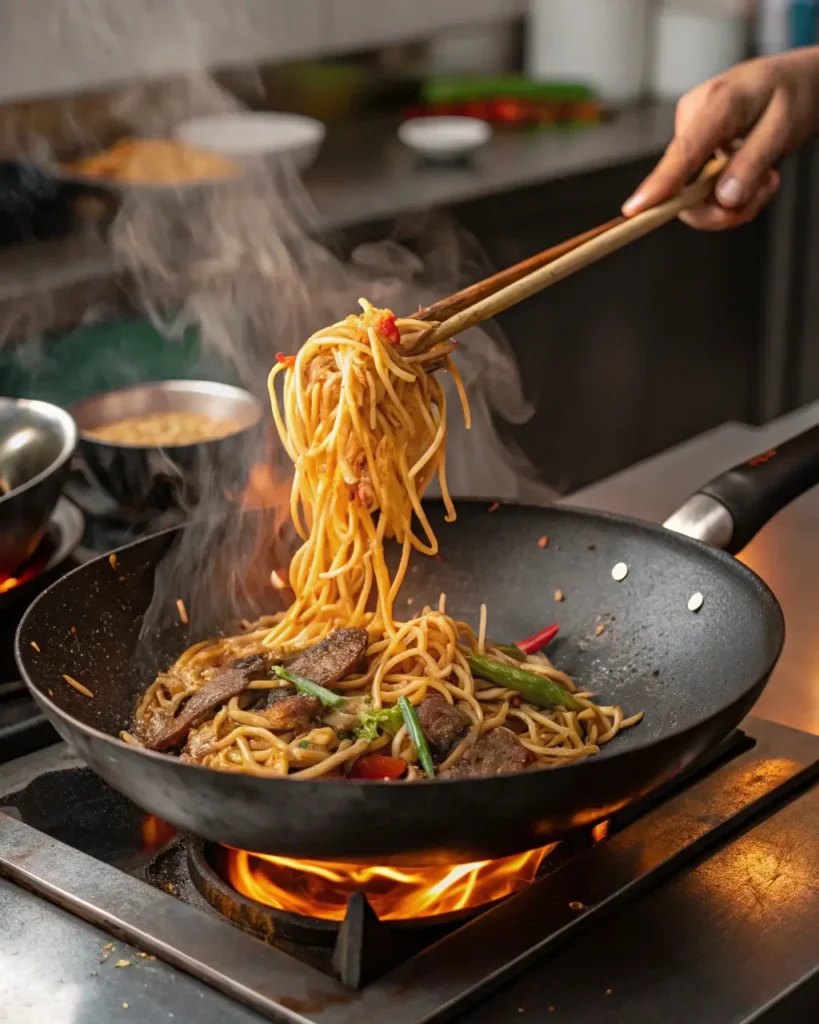
Homemade Chow Foon Recipe
Ingredients Checklist (with Substitutes)
Here’s everything you need to make an authentic beef chow foon at home. This recipe serves 2–3 people but can be easily doubled.
Main Ingredients:
- 8 oz wide flat rice noodles (fresh or soaked if dried)
- 6 oz flank steak, thinly sliced against the grain
- 2 tablespoons vegetable oil (or peanut oil)
- 2 cups bean sprouts, rinsed
- ½ onion, sliced
- 2 scallions, chopped into 2-inch pieces
For the Marinade:
- 1 tablespoon light soy sauce
- 1 teaspoon sesame oil
- ½ teaspoon cornstarch
Sauce Mix:
- 2 tablespoons dark soy sauce
- 1 tablespoon light soy sauce
- 1 teaspoon oyster sauce (or hoisin for vegan)
- 1 teaspoon Shaoxing wine (or dry sherry)
- ½ teaspoon sugar
Optional Add-ins & Swaps:
| Dietary Style | Substitution Suggestion |
|---|---|
| Vegan | Replace beef with pan-seared tofu or mushrooms |
| Gluten-Free | Use tamari instead of soy sauce |
| Low-Sodium | Use reduced-sodium soy sauce and skip oyster sauce |
| Spicy | Add chili oil or sriracha to the sauce |
Discover great ideas like our Slow Cooker Cube Steak Recipe to experiment with marinades and sauces.
Instructions for Beef Chow Foon (Classic Style)
Step 1: Marinate the Beef
Combine beef slices with light soy sauce, sesame oil, and cornstarch. Let sit for 15–20 minutes to tenderize and flavor.
Step 2: Prepare the Sauce
In a bowl, mix dark soy, light soy, oyster sauce, wine, and sugar. Stir until smooth. Set aside.
Step 3: Stir-Fry Time
- Heat 1 tablespoon oil in a very hot wok or skillet.
- Sear the marinated beef quickly (1–2 minutes), then remove.
- Add another tablespoon of oil, toss in onions and scallions. Stir-fry for 1 minute.
- Add the noodles and sauce mix. Stir-fry until everything is well coated and caramelized.
- Add back the beef and bean sprouts. Toss everything for another 30–60 seconds.
- Finish with a drizzle of sesame oil, and serve hot.
Pro Tip: Use a large spatula or tongs to gently lift and flip the noodles instead of stirring too aggressively. This keeps them intact.
Adjusting the Recipe for Vegan and Gluten-Free Diets
Going vegan or gluten-free? No problem. This chow foon recipe is super adaptable.
- For vegan chow foon, swap beef for tofu or shiitake mushrooms and use hoisin or mushroom soy in place of oyster sauce.
- For gluten-free, make sure to use gluten-free tamari and check labels on rice noodles (some may include wheat).
These swaps still give you the deep, savory flavor and rich mouthfeel of traditional chow foon—without the allergens or animal products.
Don’t miss our Ninja Foodie Recipes for more easy stovetop and pressure cooker meal ideas.
Chow Foon Nutritional Value and Health Aspects
Is Chow Foon Healthy? Calorie Breakdown
Whether chow foon is healthy or not depends on how it’s made. A standard takeout portion of beef chow foon can range from 500 to 700 calories per serving. Most of those calories come from rice noodles and oil used in stir-frying, followed by protein and sauce components.
Here’s an approximate breakdown for a classic serving:
| Nutrient | Approximate Value (per serving) |
|---|---|
| Calories | 620 |
| Protein | 25g |
| Fat | 22g |
| Carbohydrates | 80g |
| Fiber | 3g |
| Sodium | 950mg |
While the carb content is high due to rice noodles, the dish offers a balanced mix of protein, fats, and flavor, especially if you use lean meat and minimal oil.
Don’t miss our Starbucks Banana Nut Bread Recipe for a sweet treat to balance out your savory meal planning.
Low-Sodium, High-Fiber, and Protein-Rich Variants
You don’t need to sacrifice flavor to make a healthier chow foon. Here are a few simple tricks:
- Low-sodium: Use reduced-sodium soy sauce or coconut aminos.
- High-fiber: Add more vegetables like bok choy, cabbage, or snow peas.
- Protein-packed: Add egg, tofu, or double up the meat or shrimp for muscle-friendly meals.
Want to make it more filling with fewer calories? Stir-fry the noodles with zucchini strips or bean sprouts to reduce the rice noodle content without losing texture.
Meal Planning with Chow Foon for Balanced Diets
Chow foon can fit into your weekly meal plan—if portioned correctly and paired wisely. Try these ideas:
| Goal | Tip |
|---|---|
| Weight Loss | Halve the noodles, double the veggies |
| High Protein | Use flank steak and add scrambled egg |
| Heart Health | Use avocado oil, reduce soy and sodium |
| Low Carb | Mix rice noodles with shirataki noodles |
Balance it out by serving chow foon with a light soup or steamed greens. And if you’re watching your macros, divide your plate: half vegetables, a quarter protein, a quarter noodles.
Remember, it’s all about customization. Chow foon is flexible enough to meet nearly any dietary goal when prepared intentionally.
Regional Chow Foon Variations
Hong Kong-Style vs. American-Chinese Style
At its core, chow foon is a product of Hong Kong’s Cantonese cuisine. The original version, especially the famous beef chow foon (乾炒牛河), is all about simplicity—just rice noodles, beef, scallions, bean sprouts, and a whisper of soy sauce. What makes it shine is the wok hei, that irreplaceable smoky depth created over roaring flames in traditional street-side wok cooking.
In contrast, American-Chinese chow foon often adds extra vegetables, thicker sauces, and sometimes sweet undertones to suit local preferences. You’ll find carrots, broccoli, bell peppers, and sometimes even mushrooms in the mix. The sauce tends to be glossier, sometimes cornstarch-thickened, and slightly more complex to appeal to Western palates.
Here’s how they compare:
| Feature | Hong Kong Style | American-Chinese Style |
|---|---|---|
| Sauce | Light, soy-based | Thicker, sometimes sweetened |
| Flavor | Smoky, clean, umami | Bold, layered, slightly sweeter |
| Ingredients | Beef, onions, scallions, sprouts | Mixed veggies, varied meats |
| Cooking Technique | Intense high-heat wok stir-fry | More oil, sometimes pan-fried |
Each version has its fans, but both offer a delicious gateway to the world of chow foon.
Vietnamese Pho Xao and Thai-Inspired Twists
In Vietnam, a cousin to chow foon exists—pho xao. It uses similar flat rice noodles, stir-fried with beef or seafood and dressed with fish sauce, garlic, and greens. While less smoky than Hong Kong’s version, pho xao adds a layer of aromatic herbs and tangy sauces that nod to Vietnamese flavor profiles.
In Thailand, wide rice noodles are used in pad see ew—another variation similar to chow foon. Pad see ew uses dark soy sauce, garlic, Chinese broccoli, and often pork or tofu, and leans more on sweet-savory tones. The noodles are slightly caramelized, like in chow foon, but the flavor is distinctly Thai.
All these dishes show just how flexible and well-loved flat rice noodles are across Asia. They may look similar, but the flavor differences are striking—and delicious.
Fusion Chow Foon: Modern Interpretations by Chefs
Modern chefs are reimagining chow foon in exciting ways:
- Korean-Chinese hybrids include gochujang sauces or kimchi stir-ins.
- Vegan renditions add marinated jackfruit or shiitake mushrooms instead of meat.
- Some chefs use brown rice noodles or even zucchini noodles for a health-conscious spin.
You might even see chow foon tacos or chow foon noodle bowls at food trucks or modern Asian fusion restaurants. These interpretations may stray from tradition, but they celebrate the dish’s adaptability and global appeal.
No matter the version, the core identity of chow foon remains: satisfying, slurp-worthy, and packed with flavor.
Where to Buy Chow Foon Noodles and Pre-Made Options
Best Grocery Stores and Asian Markets in the US
If you’re planning to make chow foon at home, you’ll want to start with quality noodles. Luckily, they’re becoming more available in mainstream stores, especially with the growing popularity of Asian cuisine in the U.S.
Here are some top places to find flat rice noodles for chow foon:
- Asian supermarkets like H Mart, 99 Ranch Market, and Mitsuwa Marketplace often carry a variety of fresh and dried rice noodles.
- Whole Foods and Trader Joe’s may carry wide rice noodles in the international aisle, though often under fusion or health-focused branding.
- Local Asian grocers—even small corner stores—often stock fresh ho fun (refrigerated) or shelf-stable versions.
Look for packaging labeled “ho fun”, “wide rice noodles”, or “stir-fry rice noodles.” Aim for noodles that are 3/4″ to 1″ wide, which give chow foon its iconic appearance and chew.
For a sweet follow-up to your noodle adventure, check out our Starbucks Banana Nut Bread Recipe—a comforting dessert after a savory meal.
Online Chow Foon Kits and Noodle Brands
If you can’t find chow foon noodles locally, the internet has you covered. Many online Asian grocers offer both dry and fresh noodle options, and some even have complete chow foon meal kits.
Top-rated brands include:
- Twin Marquis – A trusted name in fresh noodles, often used by restaurants.
- Thai Kitchen – Known for their rice noodles, though not always the wide style.
- Lucky Boat – Popular in professional kitchens, especially for ho fun.
- A-Sha – Taiwanese brand offering premium air-dried options with great chew.
You can also shop at:
- Weee! (sayweee.com) – Great for Chinese groceries.
- Umamicart – Ships East Asian pantry staples nationwide.
- Amazon – Wide selection, but check reviews for quality and authenticity.
When buying online, check if the noodles require refrigeration. Fresh noodles should be used within days, while dried versions last longer but may need longer soaking to get the right texture.
Choosing Fresh vs. Dried Rice Noodles
Here’s a quick comparison to help you decide which kind of noodles to use in your next chow foon night:
| Type | Pros | Cons |
|---|---|---|
| Fresh | Authentic taste, better texture, no soak | Short shelf life, requires fridge |
| Dried | Long shelf life, easy to store | Needs soaking, may not stir-fry well |
| Frozen | Great texture, easy storage | Must thaw fully before use |
If it’s your first time cooking chow foon, dried noodles are more forgiving. But once you get the hang of it, fresh ho fun offers the most authentic experience.
Serving Ideas and Meal Pairing Tips
Perfect Side Dishes to Serve with Chow Foon
While chow foon is satisfying on its own, pairing it with the right side dish can create a full, restaurant-style meal at home. Because chow foon is rich, savory, and umami-heavy, the best sides are fresh, crispy, or lightly seasoned to offer contrast.
Try these simple, complementary ideas:
| Side Dish | Flavor Benefit |
|---|---|
| Steamed Bok Choy | Adds freshness and crunch |
| Chinese Hot and Sour Soup | Cuts through richness with tang |
| Egg Drop Soup | Light and savory comfort |
| Edamame with Sea Salt | Nutty balance and easy to prep |
| Cucumber Salad with Sesame | Cool, tangy, and refreshing |
These pairings enhance the chow foon experience without overshadowing its flavors. Think clean, crisp, and flavorful—but never too heavy.
Creative Leftover Ideas for Next-Day Meals
If you find yourself with leftover chow foon, don’t just reheat it—revamp it!
- Turn it into a noodle omelet: Add eggs and pan-fry until crispy on the edges.
- Make chow foon lettuce wraps: Reheat and scoop into romaine or butter lettuce.
- Toss into a noodle soup: Add to chicken or veggie broth for a warm, comforting lunch.
The key is not to microwave it to death. Instead, reheat chow foon in a hot pan or skillet with a few drops of water and a splash of soy sauce to revive its moisture and flavor.
Pairing Chow Foon with Drinks and Desserts
You’d be surprised how much a drink or dessert can round out your chow foon experience. Whether it’s a weeknight meal or a weekend gathering, thoughtful pairing goes a long way.
Beverage Pairings:
- Jasmine tea – light and floral to balance the wok smokiness
- Sparkling water with lime – refreshing and palate-cleansing
- Asian lagers (Tsingtao, Sapporo) – crisp and dry to cut through umami
Dessert Pairings:
- Mango sticky rice – for a sweet, creamy contrast
- Lychee sorbet – cooling and light after a savory main
- Fortune cookies – fun, light-hearted finish
If you’re planning a full meal, don’t miss our Crispy Salmon Bites Air Fryer as a bold appetizer that pairs wonderfully with chow foon’s depth and texture.
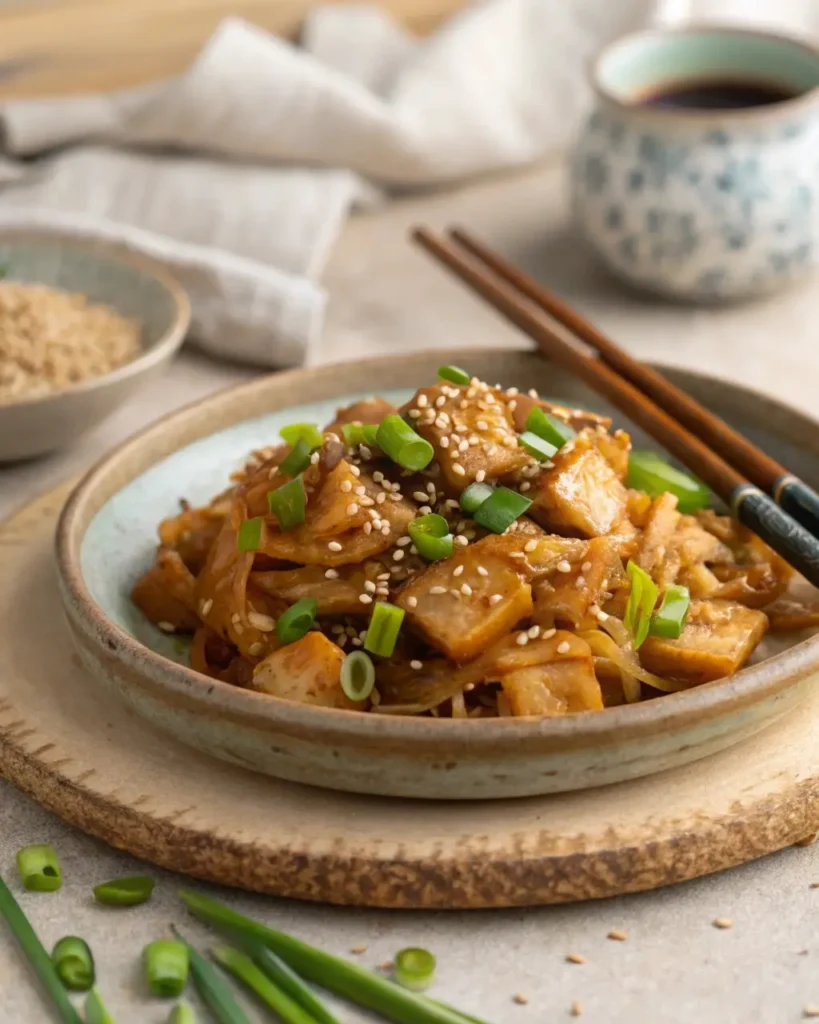
Frequently Asked Questions
What is Chinese Chow Foon?
Chow foon is a classic Cantonese noodle dish made with wide, flat rice noodles stir-fried with beef, vegetables, and savory sauces like soy and oyster sauce. Known for its tender texture and smoky flavor (wok hei), chow foon is a staple in Chinese-American restaurants and homes. The noodles are typically chewy and slippery, offering a satisfying, saucy bite in every mouthful.
What is the difference between chow mein and chow foon?
The main difference lies in the noodles and cooking style. Chow mein uses thin, wheat-based egg noodles and is often pan-fried for a crisp finish, while chow foon features wide, flat rice noodles stir-fried over high heat. Chow mein tends to be firmer or crispier, while chow foon is softer and chewier with a deeper soy-based flavor.
What is Chao Fen?
Chao fen (炒粉) is the Mandarin term for stir-fried rice noodles and is often used interchangeably with chow foon, especially in non-Cantonese regions. While chao fen can refer to any stir-fried rice noodles, chow foon specifically denotes wide, flat rice noodles and is more commonly associated with Cantonese cooking traditions.
What is chow mein made of?
Chow mein is made from egg noodles (wheat-based), stir-fried with meat (often chicken, pork, or beef), vegetables like cabbage and carrots, and seasoned with soy sauce, garlic, and sometimes hoisin or sesame oil. It’s either soft or crispy depending on the cooking method—pan-fried for crispiness or stir-fried for a tender finish.
Is Chow Mei Fun healthy?
Chow mei fun, which uses thin rice vermicelli noodles, can be healthy when cooked with lean proteins, light oil, and plenty of vegetables. It’s naturally gluten-free and lower in calories compared to chow mein. However, like chow foon, it can become calorie-dense if overloaded with oil or sugary sauces. Light stir-frying and balanced ingredients keep it nutritious.
What’s the difference between chow mein and chow choy?
While chow mein is a noodle-based dish, chow choy translates to “stir-fried vegetables” in Cantonese. Chow choy is typically a medley of seasonal veggies stir-fried in garlic, soy sauce, or oyster sauce, often served as a side. Chow mein focuses on noodles as the main ingredient, while chow choy centers around greens.
Conclusion
Whether you’re a takeout lover or an adventurous home cook, chow foon is a dish that delivers on all fronts—flavor, texture, and satisfaction. Its wide rice noodles, rich sauces, and wok-seared magic make it a standout in the world of Chinese cuisine. With a little practice, a few pantry staples, and the right technique, you can recreate authentic beef chow foon or put your own spin on it with vegan and gluten-free options.
From traditional Hong Kong street food to modern fusion creations, chow foon continues to evolve while holding on to its bold Cantonese roots. It’s hearty, adaptable, and perfect for weeknight dinners or special occasions.
Don’t miss our Ninja Foodie Recipes for more stovetop stir-fry ideas to pair with this dish.
PrintAuthentic Beef Chow Foon
This beef chow foon recipe features wide rice noodles stir-fried with marinated flank steak, crisp vegetables, and rich Cantonese sauces. A bold and savory Chinese noodle dish ready in just 30 minutes.
- Prep Time: 20 minutes
- Cook Time: 10 minutes
- Total Time: 30 minutes
- Yield: 2–3 servings
- Category: Dinner
- Method: Stir-fry
- Cuisine: Cantonese, Chinese-American
- Diet: Gluten Free
Ingredients
- 8 oz flat rice noodles (fresh or dried and soaked)
- 6 oz flank steak, thinly sliced against the grain
- 2 tbsp vegetable or peanut oil
- 2 cups bean sprouts
- ½ medium onion, sliced
- 2 scallions, cut into 2-inch pieces
Marinade:
- 1 tbsp light soy sauce
- 1 tsp sesame oil
- ½ tsp cornstarch
Sauce Mix:
- 2 tbsp dark soy sauce
- 1 tbsp light soy sauce
- 1 tsp oyster sauce (or hoisin for vegan)
- 1 tsp Shaoxing wine (or dry sherry)
- ½ tsp sugar
Instructions
- In a bowl, combine flank steak with soy sauce, sesame oil, and cornstarch. Marinate for 15–20 minutes.
- Mix all sauce ingredients in a separate bowl and set aside.
- Heat 1 tbsp oil in a hot wok. Sear beef until browned (1–2 minutes), then remove.
- Add remaining oil to the wok. Stir-fry onions and scallions for 1 minute.
- Add noodles and sauce mix. Toss quickly to coat all noodles evenly.
- Return beef and add bean sprouts. Stir-fry for another 30–60 seconds.
- Drizzle with sesame oil and serve immediately.
Notes
- Use fresh ho fun noodles for best texture.
- For gluten-free, substitute soy sauces with tamari.
- Add chili oil or Sriracha for a spicy kick.
- For vegan: sub beef with tofu and oyster sauce with mushroom soy.

